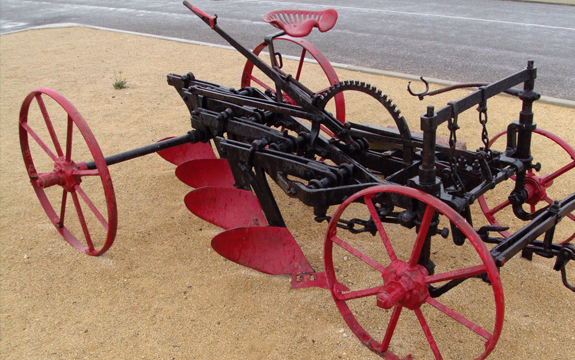The Great War brought us tragedy but it also birthed Australian science

In Summary
Tom Spurling, Swinburne University of Technology and John Mark Webb, Swinburne University of Technology
There is no question that the first world war was a tragic period in our history. But it also led to Australia seriously embracing scientific research and innovation for the first time.
In the 19th and early 20th centuries, science and technology in Australia were quite independent activities.
Innovators were often inspired dedicated individuals operating outside institutions and organisations. One example is the Peppin brothers, who through cross breeding developed the Merino strain which flourished across semi-arid Australia.
Another is William Farrer, the Cambridge mathematics graduate who became the pioneer of scientific wheat breeding in Australia. Or Lawrence Hargrave, the pioneering innovator of flight using cellular box kites.
The stump-jump plough was invented by Richard Smith in 1876 and the flotation process for the separation of minerals was patented by Melbourne brewer and chemist Charles Potter in 1901.
For science, the Official Year Book of Australia 1974 puts it quite succinctly:
Prior to the 1914-18 war, Australian science was based largely on the individual achievements of a few outstanding scientists.
One of the Year Book’s “outstanding scientists” was William H Bragg at the University of Adelaide. Bragg and his son, William L Bragg, were awarded the Nobel Prize in Physics in 1915 “for their services to the analysis of crystal structure by means of X-rays”. This is a discovery that we still put to good use at the Australian Synchrotron.
Within the general community, there was considerable public interest in current developments in science and technology. In fact science was entertainment.
The visit by Frederick Soddy to Australia in 1904 illustrates this popularity. Soddy, a rising star in the new field of radioactivity – later recipient of the Nobel Prize in Chemistry in 1921 for his work on radioisotopes – presented a series of extension lectures in Western Australia.
They were held not just in Perth but also in regional towns, to great acclaim with audiences of more than 1,000 causing shifts of venue and repeat presentations. The talks included demonstrations using equipment brought from London to illustrate the science topics causing much excitement at the time such as radioactivity, electricity and x-rays.
Into conflict
Threats of war raised the urgency of producing cordite for munitions. Cordite formulations were still derived from the original UK patent from 1889 of a mix of nitroglycerin, gun cotton and petroleum jelly, extruded as spaghetti-like rods. The Commonwealth government established a cordite factory in Maribyrnong, now an inner western suburb of Melbourne, on a then disused racecourse.
News of the use of chlorine gas on the Western Front quickly led to research at the University of Melbourne to develop gas masks for protection against chlorine. Professors David Masson, William Osborne and Thomas Laby devised the masks and tested them in a trench constructed in the Botany gardens on campus.
About 1,000 were made but were not used in France. They were superceded by British versions that provided protection from additional poison gases that had been introduced onto the battlefield.
In the lead up to Federation there was considerable advocacy for the establishment of a Federal Department of Agriculture or a Federal Bureau of Agriculture modelled on the US Department of Agriculture.
For example, the member for Bendigo, Sir John Quick, only six weeks after the Federal Parliament first assembled on May 9, 1901, moved a motion that “a national department of agriculture and productive industries on the same lines as that of the USA” be established.
Similar bills were moved in 1909 and 1913 but were not passed into law. The early years of the Commonwealth Government were quite turbulent. From 1901 to 1914 we had ten Governments and six Prime Ministers, so major initiatives were difficult. Curiously, it appears that the scientists themselves were not active participants in the debate during this period.
Seed of the CSIRO
The Commonwealth’s direct interest commenced on December 22, 1915, when Prime Minister William Morris Hughes was invited to speak at a luncheon at the University of Melbourne on a scheme for national scientific research.
William ‘Billy’ Morris Hughes, here pictured standing with three naval officers, was instrumental in promoting Australian science. Australian National Maritime Museum
Hughes was in good spirits, the day being when the last of the Australian soldiers were evacuated from Gallipoli. According to Carl Schedvin in his book Shaping Science and Industry, Hughes “announced without prior planning or consultation that his government would support the ‘idea of the national laboratory’ which would undertake major projects and co-ordinate scientific endeavour throughout the country”. Definitely a “captain’s call”!
An Advisory Council of Science and Industry was appointed in 1916, which recommended that an Institute of Science and Industry be established free from the provisions of the Public Service Act. After prolonged arguments between the Commonwealth and the States, the Science and Industry Bill was passed in 1920 and the Institute launched in 1921.
Renewed public policy interest in the role of science for industry in Australia grew in the 1920s as the UK and the Dominions worked out new economic relations in the period of post war economic uncertainty.
As a consequence, in 1925 Prime Minister Stanley M Bruce commenced a process to reform the Institute, and in May 1925 a conference of scientists, businessmen and politicians was convened to advise the government how to reform publicly funded science.
From this came the eventual creation of CSIRO, the national network of research laboratories. So one positive outcome of the war was the shifting of science from novelty to a national pursuit closely connected to our economic development.
Tom Spurling is Professor of Innovation Studies at Swinburne University of Technology.
John Mark Webb is Research Professor ( India Engagement) at Swinburne University of Technology.
This article was originally published on The Conversation. Read the original article.

